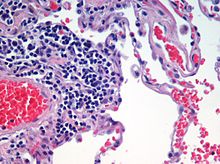
Back Weefsel Afrikaans Gewebe (Biologie) ALS Teixiu (biolochía) AN نسيج حيوي Arabic কলা (জীৱবিজ্ঞান) Assamese Texíu (bioloxía) AST Toxuma Azerbaijani توخوما AZB Туҡыма (биология) Bashkir Tisyu BCL
This article needs additional citations for verification. (February 2019) |

| Part of a series on |
| Biology |
|---|
In biology, tissue is an assembly of similar cells and their extracellular matrix from the same embryonic origin that together carry out a specific function.[1][2] Tissues occupy a biological organizational level between cells and a complete organ. Accordingly, organs are formed by the functional grouping together of multiple tissues.[3]
Biological organisms follow this hierarchy:
Cells < Tissue < Organ < Organ System < Organism
The English word "tissue" derives from the French word "tissu", the past participle of the verb tisser, "to weave".
The study of tissues is known as histology or, in connection with disease, as histopathology. Xavier Bichat is considered as the "Father of Histology". Plant histology is studied in both plant anatomy and physiology. The classical tools for studying tissues are the paraffin block in which tissue is embedded and then sectioned, the histological stain, and the optical microscope. Developments in electron microscopy, immunofluorescence, and the use of frozen tissue-sections have enhanced the detail that can be observed in tissues. With these tools, the classical appearances of tissues can be examined in health and disease, enabling considerable refinement of medical diagnosis and prognosis.
- ^ Jones, Roger (June 2012). "Leonardo da Vinci: anatomist". British Journal of General Practice. 62 (599): 319. doi:10.3399/bjgp12X649241. PMC 3361109. PMID 22687222.
- ^ Toledo-Pereyra, Luis H. (January 2008). "De Humani Corporis Fabrica Surgical Revolution". Journal of Investigative Surgery. 21 (5): 232–236. doi:10.1080/08941930802330830. PMID 19160130. S2CID 45712227.
- ^ Betts, J Gordon (25 April 2013). "1.2 Structural Organization of the Human Body – Anatomy and Physiology". Anatomy and Physiology. Openstax. ISBN 978-1-947172-04-3. Archived from the original on 2023-03-24. Retrieved 14 May 2023.